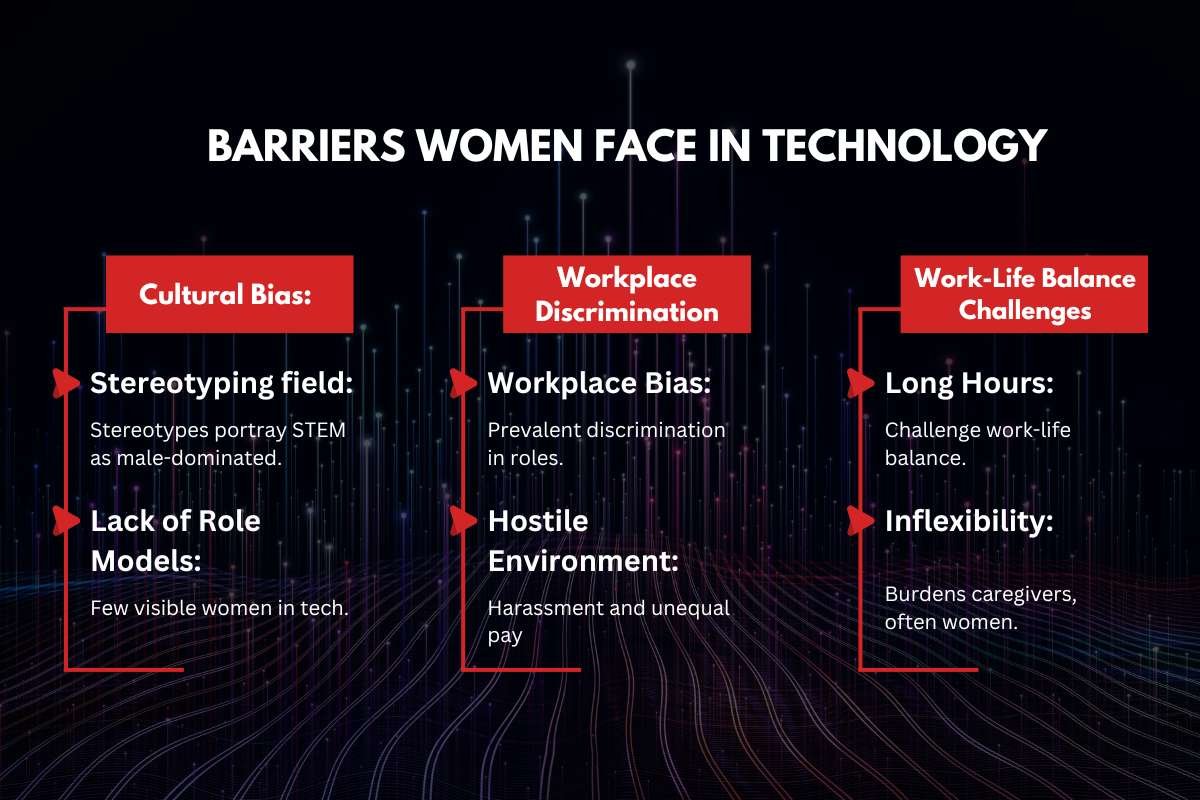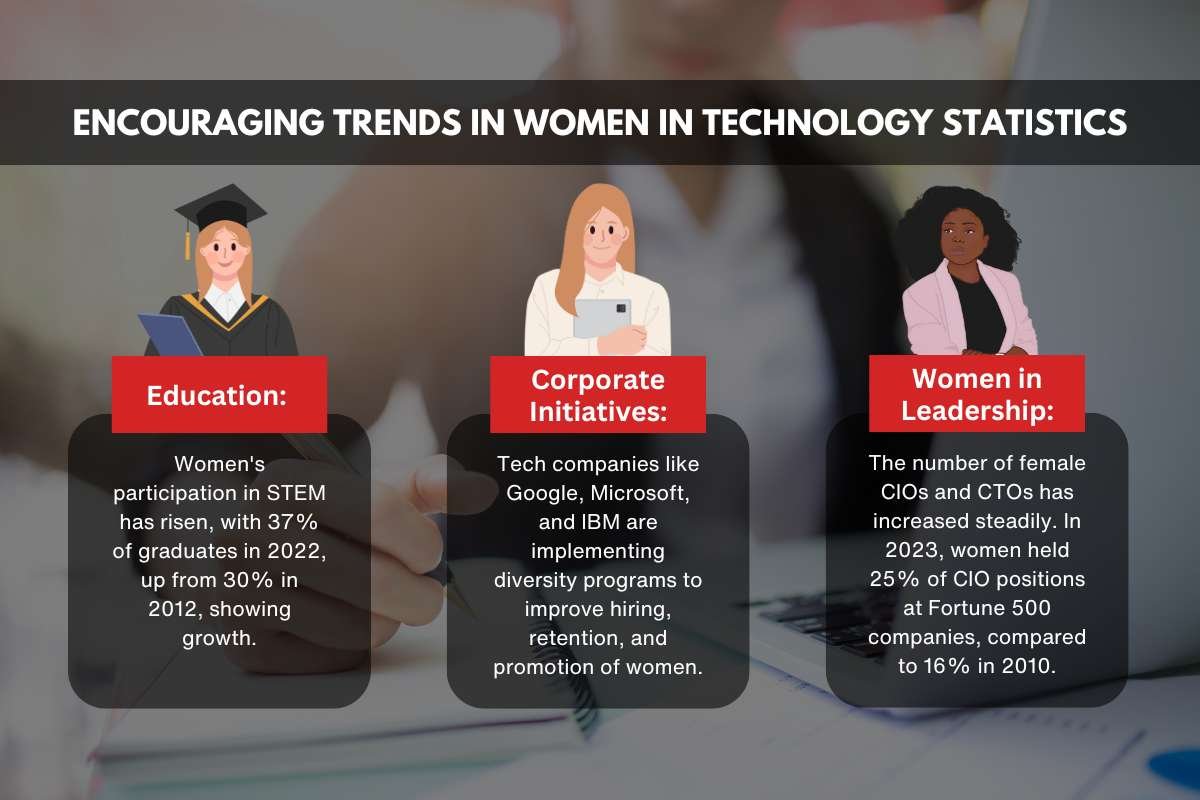Gender discrimination continues to affect the opportunities of women, mainly in male-dominated fields like technology. Women are still very few in the tech workforce, having very few leadership positions with persistent barriers such as workplace biases and limited mentorship. These issues bring an urgency to the need for initiatives that promote diversity, inclusion, and equity in the industry. In this article, we delve into these issues, analyze key Women in Technology statistics, and outline solutions to create a more inclusive tech landscape.
The Current State of Women in Technology
According to some reports, women constitute around 28% of the technology workforce across the globe. This count is a modest improvement from when the decade was a long time ago but still calls for attention to the immense gender gap in comparison with other industries. According to the National Center for Women & Information Technology, approximately 25% of computing-based jobs in the United States are held by women.
The numbers reveal additional disparities:
- Leadership roles: Women hold 16% of executive-level positions in technology companies.
- Technical roles: Only 20% of software developers and 15% of engineers are women.
- Representation in startups: In the startups, only 2.3% of the venture capital funding in 2022 went to female-founded companies.
These women in technology statistics point out the imperative need for systemic changes to create an inclusive and equitable tech industry.
Barriers Women Face in Technology

Several interlinked factors can be attributed to the underrepresentation of women in technology. Here are some of the major barriers:
1. Cultural Bias:
- Stereotyping field: Stereotypes portray STEM as male-dominated.
- Lack of Role Models: Few visible women in tech.
2. Workplace Discrimination:
- Workplace Bias: Prevalent discrimination in roles.
- Hostile Environment: Harassment and unequal pay
3. Work-Life Balance Challenges:
- Long Hours: Challenge work-life balance.
- Inflexibility: Burdens caregivers, often women.
Encouraging Trends in Women in Technology Statistics

Despite all these challenges still persistent in the sector, there are positive trends that show progress:
These encouraging statistics over women in technology are the results of continuous efforts on the part of educators, organizations, and advocacy groups.
The Economic Case for Gender Diversity in Tech
Closing the gap in technology is not only a moral imperative, but it is also an economic one. Studies have consistently shown that diverse teams lead to higher innovation, production, and profitability. Indeed, a report by McKinsey states that companies leading in gender diversity on the executive teams are 21 percent more likely to outperform their peers in terms of profitability.
Moreover, the talent shortage in the tech industry could be mitigated by increasing female participation. The World Economic Forum estimates that achieving gender parity in labor markets could add $12 trillion to global GDP by 2025. These statistics make it clear that empowering women in technology is not only a fairness issue but also a smart business strategy.
Programs and Policies Driving Change
Around the globe, these programs and policies have targeted removing the barriers and enhancing women’s representation. Here are some inspiring programs.
- Girls Who Code: This nonprofit foundation hopes to bridge the gender divide in technology by educating, supporting, and providing necessary tools to young girls that could help them in computer programming.
- Mentorship Programs: Organizations including “Lean In Circles,” a branch of “Million Women Mentors” provide women in technological ventures with mentors to aid professional improvement.
- Corporate Pledges: Organizations like Accenture and Salesforce have set ambitious goals to achieve gender parity in their workforces by 2030.
- Government Initiatives: Countries like Canada and the UK are funding STEM education programs for girls and offering incentives to tech companies that prioritize diversity.
These efforts are gradually moving the needle, as reflected in evolving women in technology statistics over the years.
How Organizations Can Further Bridge the Gender Gap?
Organizations need to have a multi-faceted approach to fostering an inclusive tech culture. Here are some actionable strategies:
- Recruitment Practices: Ensure that job postings and hiring processes are free of gender bias. Utilize blind recruitment techniques to level the playing field.
- Pay Equity Audits: Regularly review and address pay gaps within the organization.
- Flexible Work Policies: Offering remote work, flexible hours, and parental leave can make tech careers more accessible to women.
- Training and Development: It should train all employees continuously to address unconscious bias and create an inclusive culture at work.
The Future of Women in Technology

The journey to gender parity in technology is long, but progress is not in question. With the help of systemic barriers to change and the development of an inclusive culture, the industry has a good chance of blossoming. According to new statistics on women in technology, it is now appearing that such efforts are just beginning to bear fruit, but there is much more to go.
The future is bright for aspiring women in tech. As resources, mentorship, and opportunities grow, a new generation of women is ready to break the barriers and redefine the tech landscape. It is up to companies, policymakers, and society at large to continue making progress because a more diverse and equitable technology industry benefits everyone.
Conclusion
The underrepresentation of women in technology remains at large; however, awareness and actions are taking a great deal around this. Stakeholders, by the data-driven insights, especially by the latest women in technology statistics, can figure out gaps and implement appropriate solutions. By doing this together, we can have a tech industry that not only leads to innovation but also represents the world it is trying to serve.









